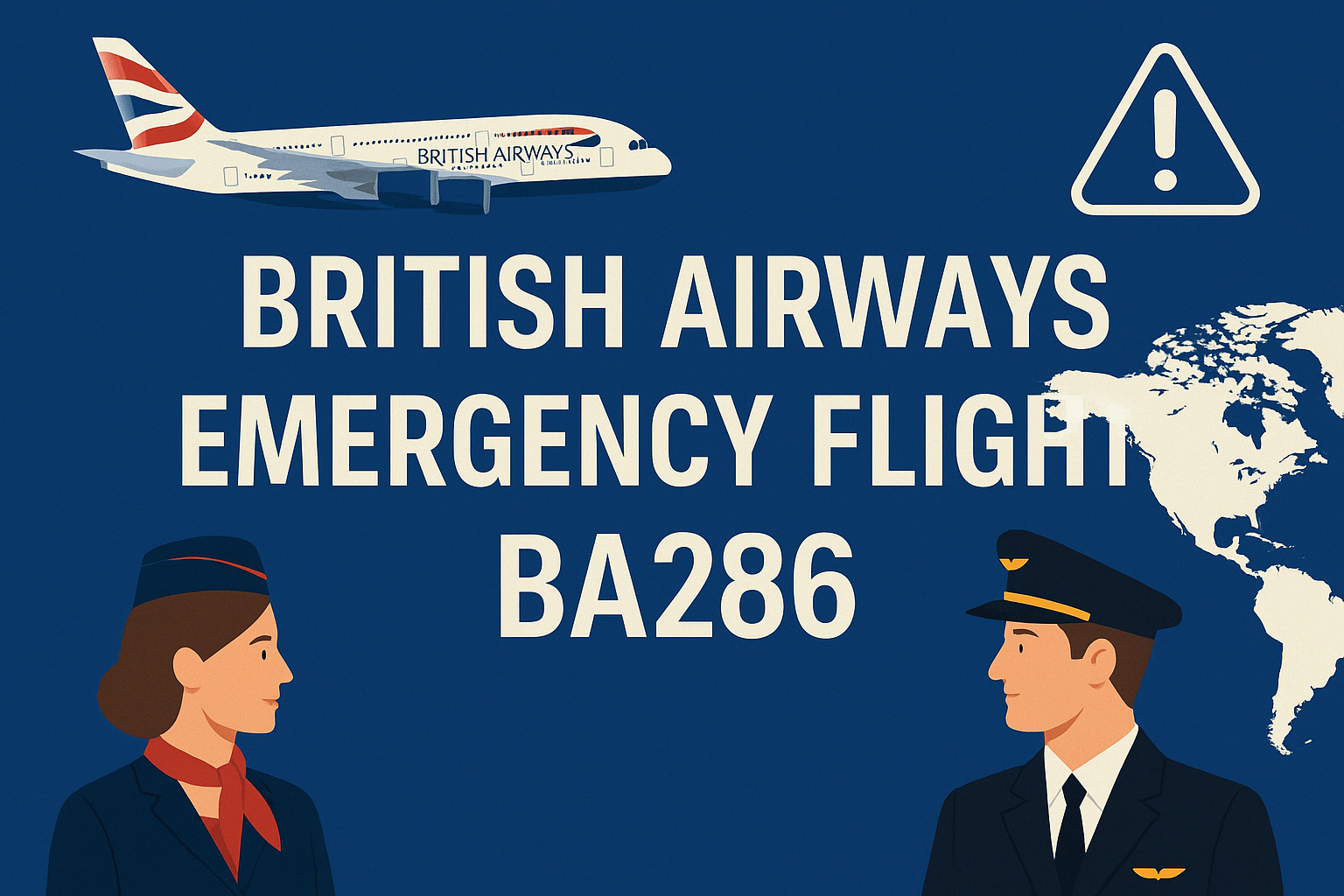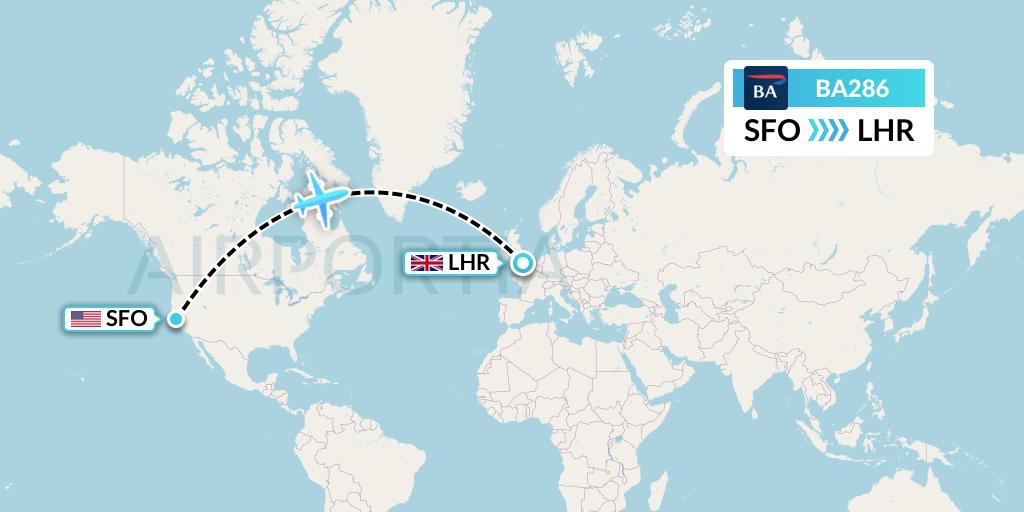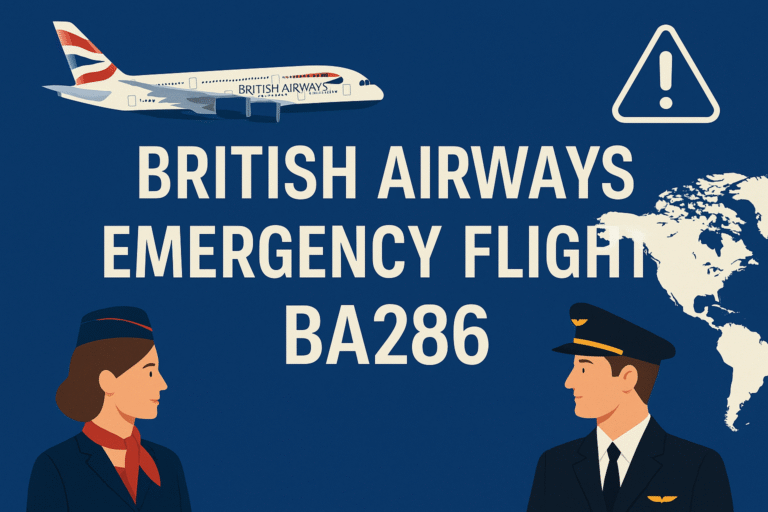
Introduction
The story of British Airways emergency flight BA286 captures aviation drama, careful crisis-management, and safety learning in one incident. The flight designation “BA286” (or BA 286) refers to a long-haul route between San Francisco (SFO) and London Heathrow (LHR). On a particular flight, the airline declared an emergency—and that decision triggered media attention, passenger concern, and regulatory follow-up.
In this article, we unpack the timeline, causes, airline response, safety factors, and lessons learned. We place the event in context, compare it to other similar incidents, and answer frequent questions about what it meant for passengers, crew, and future flights. Throughout, you’ll find references to “British Airways emergency flight BA286” to keep clarity for search engines and human readers alike.
“We just sat there in silence, being very British,” said one passenger on the 2016 BA286 diversion.

What was British Airways emergency flight BA286?
The term “British Airways emergency flight BA286” refers to the flight number BA286 operated by British Airways, which at one point declared a general emergency. Specifically, according to aviation-tracking sources, BA286, operating an Airbus A380 registered G-XLEG, departed San Francisco and en route declared “squawk 7700” (the standard transponder code for emergency).
Historically, there are at least two notable events associated with BA286:
- A 2016 incident where BA 286 from San Francisco to London diverted to Vancouver after crew illness.
- A more recent 2025 event was reported as the “British Airways emergency flight BA286,” where a flight declared an emergency and landed safely.
In other words, when we speak of “British Airways emergency flight BA286,” we are primarily referring to the 2025 declaration of emergency, though the earlier incident provides useful context.
Detailed Timeline of the Incident
Pre-flight & departure
Flight BA286 was scheduled on 26 May 2025 to depart San Francisco International Airport (SFO) bound for London Heathrow (LHR). The aircraft was an Airbus A380 registered G-XLEG.
En-route declaration of emergency
Shortly after take-off, the crew declared a general emergency (squawk 7700) while en route. The exact trigger was reported as a medical incident on board, though full details remain under investigation.
Immediate diversion & landing
Following the emergency call, the aircraft made arrangements for a diversion and ultimately landed safely at its destination (or alternate airport) under emergency priority. Reports state the airline and airport confirmed the flight landed without further escalation.
Post-landing and investigation
After landing, passengers and crew were attended by airline staff, and authorities began assessing the cause. A key point: in the earlier 2016 event, crew illness (22–25 crew) was central. The 2025 version similarly references a medical condition or onboard health event as the reason for declaring the emergency.
Summary of key dates
- 2016-10-25: BA286 diverted to Vancouver due to crew illness mid-flight.
- 2025-05-26: BA286 declared an emergency and landed safely; the investigation continues.

What caused the emergency on BA286?
When exploring “British Airways emergency flight BA286,” we must separate confirmed facts from investigation-stage information.
Confirmed facts
- The aircraft declared squawk 7700—the radio code for “general emergency.”
- The airline acknowledged a medical incident on board in the 2025 scenario.
- In the 2016 incident, the crew became unwell (reports vary between 20–25 crew plus some passengers), and the flight was diverted.
Potential causes under scrutiny
- Smoke or fume exposure/odor reported onboard (in 2016). One account described a burning-plastic smell that preceded symptoms in the crew.
- Crew fatigue or medical issues may have contributed (though not confirmed).
- Aircraft systems or air-quality issues: when multiple crew members fall ill simultaneously, attention turns to cabin ventilation, bleed-air systems, or environmental contamination.
- The airline’s statement focused on the safety of customers and crew and indicated investigations were ongoing.
Why no definitive public cause yet
Investigations into aviation incidents can take months or years. While immediate safety actions are taken, detailed root-cause analysis (e.g., on the aircraft’s systems, cabin environment, crew health, and flight logs) remains confidential until an official report is published. For “British Airways emergency flight BA286,” the public sources do not yet provide a full causal report.

Impact on Passengers, Crew & British Airways
Passengers
Passengers aboard British Airways emergency flight BA286 experienced disruption: diversion, emergency landing, and subsequent re-booking or delay. In the earlier 2016 case, passengers were hospitalized as a precaution, although not for smoke inhalation per the airline.
Crew
Crew health and safety were central. In the 2016 case, more than 20 crew members sought hospital checks. In 2025, the “medical incident” wording suggests that at least one crew member required attention.
British Airways
For British Airways, the incident represented reputational and operational risk. Emergency declarations trigger regulatory scrutiny and possible compensation obligations and intensify media coverage. On the positive side, the airline’s decision-making (declaring an emergency and diverting) can be credited as risk-averse and passenger-safety oriented.
More Read About: Fonendi: Ultimate Guide to Understanding and Utilizing It
BA286 vs. Other Notable BA Emergencies
| Flight | Aircraft/Route | Trigger | Outcome | Relevance to BA286 |
| BA286 (2025) | A380 SFO → LHR | Medical incident onboard, emergency declared | Landed safely | Direct subject of the article |
| BA286 (2016) | A380 SFO → LHR, diverted to YVR | Crew illness, possible fumes | Diversion, hospital checks | An earlier version of the identical flight number |
| BA2276 (2015) | 777-200 LAS → LHR | Uncontained engine fire at take-off | Evacuation, no fatalities | Demonstrates operational risk in BA’s fleet |
| BA603 (2025) | A320 IST → LHR | Smoke reported onboard, diverted to Bucharest | Landed, no major injuries | Shows a similar pattern of in-flight emergency |
This table shows how “British Airways emergency flight BA286” fits into a broader pattern of emergency declarations by BA flights when onboard health or technical issues appear.
Safety Implications & What Changed
Implication 1: Air quality & cabin environment
When multiple crew members become ill, cabin air quality becomes a suspect. The bleed-air or ventilation systems on large aircraft like the A380 may be reviewed. Passengers and crew are less visible to immediate risks, so the emergency demonstrates how latent hazards can surface.
Implication 2: Emergency declaration protocols
BA’s decision to squawk 7700 and divert shows that declaring an emergency is a prudent option rather than waiting for a full diagnosis. For airlines and crews, this reinforces training, decision thresholds, and communication with ATC (Air Traffic Control).
Implication 3: Passenger information & support
Incidents like BA286 test how airlines manage passenger care: diversion logistics, hotel accommodations, medical triage, re-booking, and communication. In the earlier 2016 incident, the airport handled baggage transfers and hotel re-bookings.
Implication 4: Investigation & transparency
While immediate safety is the priority, longer-term learning depends on a full investigation. The public may not yet know the root cause of the BA286-2025 incident; transparency builds trust and improves industry standards.
What Passengers Should Know If They’re On BA286 or Similar Flights
If you hold a ticket on British Airways emergency flight BA286 or a comparable long-haul BA flight:
- Understand emergency procedures: the cabin crew will instruct you.
- Stay alert to announcements: in case of emergency, follow crew instructions and remain seated unless asked to evacuate.
- Insurance and rights: in diversions, you may be entitled to accommodation, alternative flights, or compensation—depending on circumstances and jurisdiction.
- Medical issues onboard: report symptoms to the cabin crew immediately—even if you think they are minor.
- After landing and diversion: keep records of flight number, times, announcements, and any medical or official statements from the airline—they may help with later claims.
Conclusion
The event known as “British Airways emergency flight BA286” underscores how even routine long-haul services can face sudden, serious disruptions. From the 2016 diversion to Vancouver to the 2025 emergency declared en route from San Francisco to London, the flight number BA286 has become a case study in risk, response, and airline safety culture. While the full root-cause of the 2025 incident remains under investigation, the airline’s proactive diversion decision, the attention to crew health, and passenger support stand out. For travelers, crew, and aviation bodies, the incident is a reminder of the need for vigilance, clear communication, and robust safety systems in the skies.
FAQ About British Airways Emergency Flight BA286
Q1: What exactly happened on the British Airways emergency flight BA286?
The flight number BA286, travelling from San Francisco to London, declared a general emergency (squawk 7700) en route in May 2025, reportedly due to a medical incident onboard. The aircraft landed safely, and no public report yet details the full technical cause.
Q2: Was there a previous incident involving BA286?
Yes. In October 2016, British Airways emergency flight BA286 (same route) diverted to Vancouver because more than 20 crew members became unwell. That event is separate but often referenced in discussing BA286’s history.
Q3: Did any passengers die on British Airways’ emergency flight BA286?
No fatalities have been reported for either the 2025 or the 2016 BA286 incidents. Some crew and passengers sought medical attention in 2016, but all were discharged.
Q4: What compensation or rights do passengers of British Airways’ emergency flight BA286 have?
When an emergency results in diversion or delay, passengers may be eligible for accommodation, meals, alternative routing, and possible compensation under UK/EU regulations or airline policy. For BA286 passengers, the specifics depend on circumstances (length of delay, reason for diversion). It’s wise to retain all documentation (flight number, announcements, receipts).
Q5: What safety lessons were drawn from British Airways’ emergency flight BA286?
Key lessons include the importance of immediate emergency declaration (as BA did via squawk 7700), attention to cabin-air quality and crew health, robust passenger care in diversions, and transparent investigation. For BA and the wider industry, the incident reinforces that health-related events onboard can escalate quickly and must be treated with priority.






